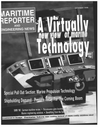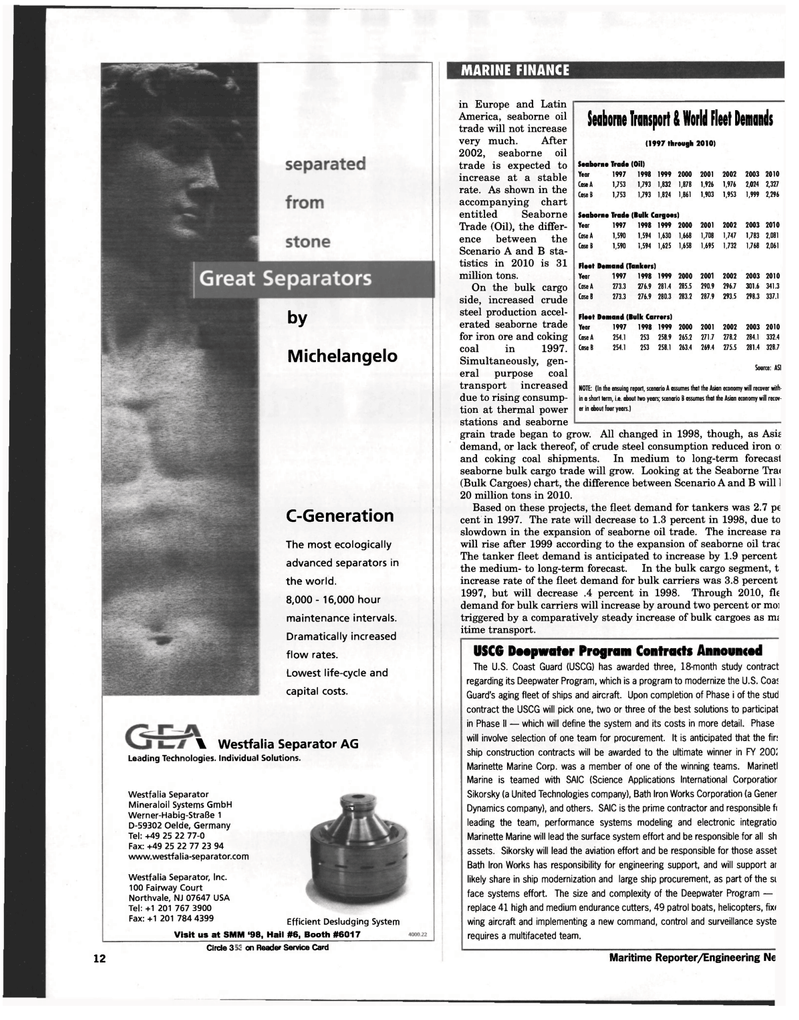
Page 12: of Maritime Reporter Magazine (September 1998)
Read this page in Pdf, Flash or Html5 edition of September 1998 Maritime Reporter Magazine
MARINE FINANCE by
Michelangelo
C-Generation
The most ecologically advanced separators in the world. 8,000 - 16,000 hour maintenance intervals.
Dramatically increased flow rates.
Lowest life-cycle and capital costs. % Westfalia Separator AG
Leading Technologies. Individual Solutions.
Westfalia Separator
Mineraloil Systems GmbH
Werner-Habig-StraBe 1
D-59302 Oelde, Germany
Tel: +49 25 22 77-0
Fax: +49 25 22 77 23 94 www.westfalia-separator.com
Westfalia Separator, Inc. 100 Fairway Court
Northvale, NJ 07647 USA
Tel: +1 201 767 3900
Fax: +1 201 784 4399
T-
Efficient Desludging System
Visit us at SMM '98, Hail #6, Booth #6017
Seaborne Transport t World Fleet Demands (1997 through 2010)
Seaborne Trade (Oil)
Year 1997 1998
Case A 1,753 1,793
Case B 1,753 1,793 1999 1,832 1,824 2000 1,878 1,861
Seaborne Trade (Bulk Cargoes)
Year 1997 1998 1999 2000
Case A 1,590 1,594 1,630
Case B 1,590 1,594 1,625 1,668 1,658
Fleet Demand (Tankers)
Year 1997 1998 1999
Case A 273.3 276.9 281.4
Case B 273.3 276.9 280.3
Fleet Demand (Bulk Carrers)
Year 1997 1998 1999
Case A 254.1 253 258.9
Case B 254.1 253 258.1 2000 285.5 283.2 2000 265.2 263.4 2001 1,926 1,903 2001 1,708 1,695 2001 290.9 287.9 2001 271.7 269.4 2002 1,976 1,953 2002 1,747 1,732 2002 296.7 293.5 2002 278.2 275.5 2003 2,024 1,999 2003 1,783 1,768 2010 2,327 2,296 2010 2,081 2,061 2003 2010 301.6 341.3 298.3 337.1 2003 284.1 281.4 2010 332.4 328.7 in Europe and Latin
America, seaborne oil trade will not increase very much. After 2002, seaborne oil trade is expected to increase at a stable rate. As shown in the accompanying chart entitled Seaborne
Trade (Oil), the differ- ence between the
Scenario A and B sta- tistics in 2010 is 31 million tons.
On the bulk cargo side, increased crude steel production accel- erated seaborne trade for iron ore and coking coal in 1997.
Simultaneously, gen- eral purpose coal transport increased due to rising consump- tion at thermal power stations and seaborne grain trade began to grow. All changed in 1998, though, as Asit demand, or lack thereof, of crude steel consumption reduced iron o: and coking coal shipments. In medium to long-term forecast seaborne bulk cargo trade will grow. Looking at the Seaborne Trai (Bulk Cargoes) chart, the difference between Scenario A and B will 1 20 million tons in 2010.
Based on these projects, the fleet demand for tankers was 2.7 pe cent in 1997. The rate will decrease to 1.3 percent in 1998, due to slowdown in the expansion of seaborne oil trade. The increase ra will rise after 1999 according to the expansion of seaborne oil trac
The tanker fleet demand is anticipated to increase by 1.9 percent the medium- to long-term forecast. In the bulk cargo segment, t increase rate of the fleet demand for bulk carriers was 3.8 percent 1997, but will decrease .4 percent in 1998. Through 2010, fie demand for bulk carriers will increase by around two percent or moi triggered by a comparatively steady increase of bulk cargoes as m; itime transport.
Source: AS1
NOTE: (In the ensuing report, scenario A assumes that the Asian economy will recover with- in a short term, i.e. about two years; scenario B assumes that the Asian economy will recov- er in about four years.)
Circle 308 on Reader Service Card
USCG Deepwater Program Contracts Announced
The U.S. Coast Guard (USCG) has awarded three, 18-month study contract regarding its Deepwater Program, which is a program to modernize the U.S. Coa$
Guard's aging fleet of ships and aircraft. Upon completion of Phase i of the stud contract the USCG will pick one, two or three of the best solutions to participat in Phase II — which will define the system and its costs in more detail. Phase will involve selection of one team for procurement. It is anticipated that the fir; ship construction contracts will be awarded to the ultimate winner in FY 200;
Marinette Marine Corp. was a member of one of the winning teams. Marinetl
Marine is teamed with SAIC (Science Applications International Corporatior
Sikorsky (a United Technologies company), Bath Iron Works Corporation (a Gener
Dynamics company), and others. SAIC is the prime contractor and responsible fi leading the team, performance systems modeling and electronic integratio
Marinette Marine will lead the surface system effort and be responsible for all sh assets. Sikorsky will lead the aviation effort and be responsible for those asset
Bath Iron Works has responsibility for engineering support, and will support at likely share in ship modernization and large ship procurement, as part of the si face systems effort. The size and complexity of the Deepwater Program — replace 41 high and medium endurance cutters, 49 patrol boats, helicopters, fixi wing aircraft and implementing a new command, control and surveillance syste requires a multifaceted team. 12 Maritime Reporter/Engineering Newc

 11
11

 13
13
